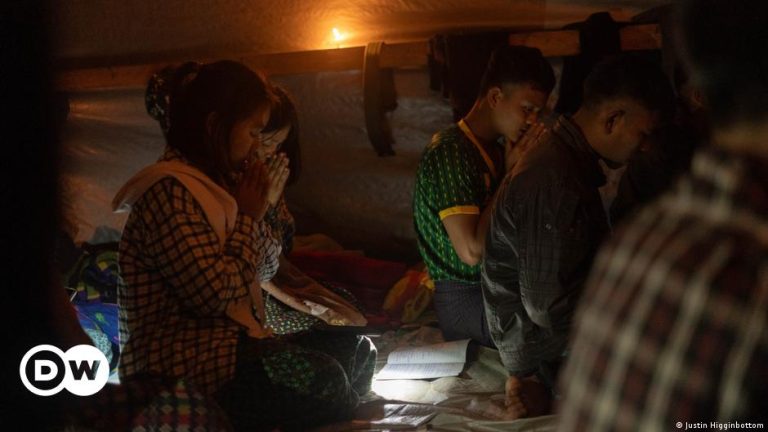On a Saturday evening, young fighters from the “Chinland Defense Forces” fill the floor of a tarpaulin-covered room in their mountain base, chanting Buddhist texts lit by candles and smartphones.
This is the headquarters of Chinland Defense Forces Battalion 4 – Kalay, Kabaw, Gangaw (CDF-KKG). And for the Buddhists in this resistance group, Saturday is dedicated to prayer.
The CDF-KKG is fighting Myanmar’s military junta, which has lost ground in recent months across the country to a armed ethnic militias who launched an offensive. The junta seized power in a coup in 2021, and conflict between the military and resistance groups has continued since.
Battalion 4’s base, in the northeastern part of Chin State, is carved into a mountain overlooking the townships of the Sagaing border region.
The army invaded its former base in the valley. The thick forest cover of the mountainside provides protection against attacks by the junta’s jets and drones.

Ethnic groups unite to fight against the junta
Chinland Defense Force groups linked to geographic areas of Chin State are predominantly composed of Chin Christians.
However, the CDF-KKG has a more mixed membership and also includes Bamar Buddhists – the majority ethnic and religious group in Myanmar. Fighters from diverse backgrounds defend the ideas of equality they want for their country.
Sin Bout, 23, comes from a Buddhist family in Kale township, in the Sagaing region. He left the university after the 2021 coup and joined the CDF-KKG in March 2022.
He told DW that he learned in public schools that the various ethnic armies fighting the Myanmar military were terrorists. This included the Chin National Army, which supports defense force groups like his.
“After the coup, I know they are not terrorists. They are fighting for their freedom,” he said, explaining that was why he joined the fight.
On Sunday there is a Christian service. The resistance fighters play guitar and sing gospel songs.
Sang Nu, a Chin Christian, left medical school to join the CDF-KKG. The 23-year-old told DW she thought her knowledge of medicine could prove useful, especially to the other young women in the group.
She experienced varying degrees of religious discrimination as a child, she said. She explained that new Christian churches could not obtain permits while Buddhist temples were multiplying. Ethnic minorities such as the Chin appeared to be overlooked for government jobs.
That’s part of the reason she joined the resistance, she said, explaining that she wanted more independence for her community but was happy to work alongside others, like the Bamars, who are his compatriots.
Junta attempts to exploit religious divisions
Since the coup d’état, the junta has examined religious divisions in Myanmar for legitimacy.
A report from the American Institute of Peace indicates that the head of the junta, Min Aung Hlaing, had attempted to position himself as a protector of Buddhism, making frequent public appearances to Buddhist leaders.
Measuring 25 meters high, the world’s largest sculpture of a seated Buddha was completed in July in the capital, Naypyidaw.
Sang Nu said there was no tension between the different ethnic and religious fighters in Battalion 4. “We feel like we are one family. Our enemy is only the army,” she said.
The biggest problems they faced were the lack of medical supplies and weapons, she added. However, she also stressed that the resistance could do more to include women, who make up at least 10% of her battalion but are rarely sent to the front line. She said women can contribute more than just providing medical care in the rear.
Resistance attracts local support
In the valley below the mountainous base of the CDF-KKG, near the town of Kale controlled by the junta, an old wooden boarding school no longer welcomes students, but a constant flow of resistance fighters.
Austin Mon, 51, was once the manager. He experienced two uprisings against the army – in 1988 and 1996. He supported the democratic movement then, but did not get involved in activism. His parents told him it was too dangerous.
Now that he has a family of his own, he sees this conflict as his last chance to fight for democracy. After closing his school, he became vice-president of the CDF-KKG.

Austin Mon said about a fifth of his former students also joined the resistance group — young people from diverse ethnic, religious and economic backgrounds.
“When I saw my former students joining the CDF, I felt proud. But when they go to the front, I worry. They are always in my thoughts when they leave. I can neither eat nor sleep”, did he declare.
Despite this, he said he would fight until the end. This revolution could not be missed, he said.
Sin Bout of Battalion 4 also said he would not return home until the war was over. “I miss my family and my friends. But we have no choice. We feel it is our duty,” he said.
He explained that his ideal Myanmar would be a country where there was equal treatment for all ethnic and religious groups, freedom of expression and economic opportunities.
He said the military had stolen these things from his generation – as it had from others before it.
In the cool mountain air of the camp, Sin Bout played his acoustic guitar and sang songs he had written about the revolution and the fight for a free Myanmar.
Edited by: Wesley Rahn


